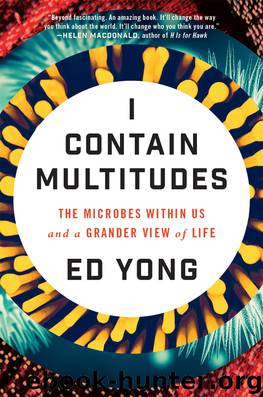I Contain Multitudes by Ed Yong

Author:Ed Yong
Language: eng
Format: epub
Publisher: HarperCollins
Published: 2016-06-24T16:00:00+00:00
8. ALLEGRO IN E MAJOR
When you were born, you inherited half your genes from your mother and half from your father. That’s your lot. Those inherited bits of DNA will remain with you for all of your life, with no further additions or omissions. You can’t have any of my genes, and I can’t acquire any of yours. But imagine a different world where friends and colleagues can swap genes at will. If your boss has a gene that makes her resistant to various viruses, you can borrow it. If your child has a gene that puts him at risk of disease, you can swap it out for your healthier version. If distant relatives have a gene that allows them to better digest certain foods, it’s yours. In this world, genes aren’t just heirlooms to be passed on vertically from one generation to the next, but commodities to be traded horizontally, from one individual to another.
This is exactly the world that bacteria live in. They can exchange DNA as easily as we might exchange phone numbers, money, or ideas. Sometimes, they sidle up to one another, create a physical link, and shuttle bits of DNA across: their equivalent of sex. They can also scrounge up discarded bits of DNA in their environment, left by their dead and decaying neighbours. They can even rely on viruses to move genes from one cell to another. DNA flows so freely between them that the genome of a typical bacterium is marbled with genes that arrived from its peers. Even closely related strains might have substantial genetic differences.1
Bacteria have been carrying out these horizontal gene transfers, or HGT for short, for billions of years, but it wasn’t until the 1920s that scientists first realised what was happening.2 They noticed that harmless strains of Pneumococcus could suddenly start causing disease after mingling with the dead and pulped remains of infectious strains. Something in the extracts had changed them. In 1943, a “quiet revolutionary” named Oswald Avery showed that this transformative material was DNA, which the non-infectious strains had absorbed and integrated into their own genomes.3 Four years later, a young geneticist named Joshua Lederberg (who would later popularise the word “microbiome”) showed that bacteria can trade DNA more directly. He worked with two strains of E. coli, each of which was unable to make different nutrients. Unless they received supplements, these bacteria would die. But when Lederberg mixed the two strains together, he found that some of their daughters could survive without any help. It became clear that the two parental strains had horizontally exchanged genes that compensated for each other’s shortcomings. The daughters then vertically inherited a complete working set, and thrived.4
Sixty years on, we know that HGT is one of the most profound aspects of bacterial life. It allows bacteria to evolve at blistering speeds. When they face new challenges, they don’t have to wait for the right mutations to slowly amass within their existing DNA. They can just borrow adaptations wholesale, by picking up genes from bystanders that have already adapted to the challenges at hand.
Download
This site does not store any files on its server. We only index and link to content provided by other sites. Please contact the content providers to delete copyright contents if any and email us, we'll remove relevant links or contents immediately.
| Cell Biology | Developmental Biology |
| Entomology | Marine Biology |
| Microbiology | Molecular Biology |
| Biostatistics |
Sapiens: A Brief History of Humankind by Yuval Noah Harari(14252)
The Tidewater Tales by John Barth(12608)
Mastermind: How to Think Like Sherlock Holmes by Maria Konnikova(7227)
Do No Harm Stories of Life, Death and Brain Surgery by Henry Marsh(6891)
The Thirst by Nesbo Jo(6827)
Why We Sleep: Unlocking the Power of Sleep and Dreams by Matthew Walker(6618)
Life 3.0: Being Human in the Age of Artificial Intelligence by Tegmark Max(5474)
Sapiens by Yuval Noah Harari(5294)
The Longevity Diet by Valter Longo(5019)
The Body: A Guide for Occupants by Bill Bryson(4974)
The Rules Do Not Apply by Ariel Levy(4861)
The Immortal Life of Henrietta Lacks by Rebecca Skloot(4525)
Animal Frequency by Melissa Alvarez(4395)
Why We Sleep by Matthew Walker(4360)
The Hacking of the American Mind by Robert H. Lustig(4318)
Yoga Anatomy by Kaminoff Leslie(4306)
All Creatures Great and Small by James Herriot(4232)
Double Down (Diary of a Wimpy Kid Book 11) by Jeff Kinney(4207)
Barron's AP Biology by Goldberg M.S. Deborah T(4097)
